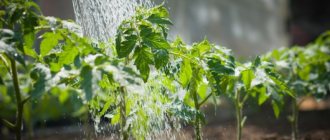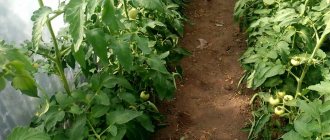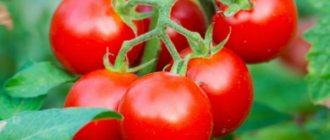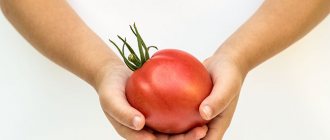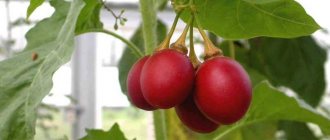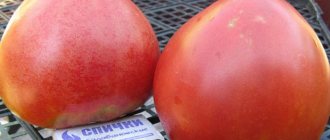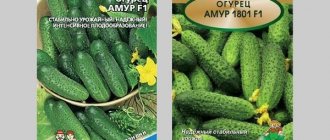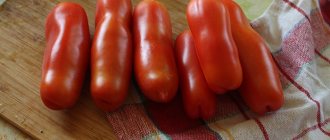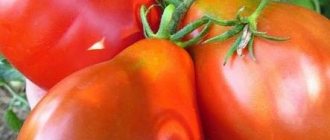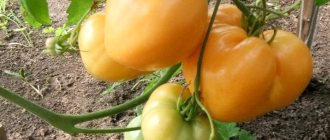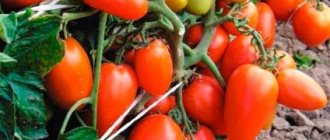The problem with most famous tomatoes with good taste is that a large number of gardeners want to see these varieties in their plots, and often there is confusion with the seeds of tomato species. Breeders with a guilty conscience are burning with a great desire to quickly sell under the name of the famous variety something else that differs from the true one, in general, a fake. At times, not only seeds are confused, but also varietal names. This happened with our variety called “Sevruga”. He is often called "Pudovik". But “Pudovik” appeared earlier than “Sevryuga”, and has been listed in the state register since 2007. And the stellate sturgeon tomato is not included in the state register at all.
Scrupulous vegetable growers have already checked and rechecked these varieties a hundred times. They even grew them side by side in one place. And they concluded that these varieties are almost identical in all respects, and, therefore, they are one variety.
Some people think that the tomato variety Sevryuga = Pudovik, only more adapted to the northern and Siberian climate. From this assumption the opinion was born that this is one variety that has 2 different names. Officially the variety is called “Pudovik”, and popularly it is called “Sevruga”.
In this material we will look at the characteristic features of tomatoes grown under two names.
Description
The Sevruga tomato is not included in the State Register of the Russian Federation. While Pudovik is present. The varieties are very similar to each other, so gardeners began to use their names as interchangeable synonyms.
Sevruga is a determinate plant. In open ground, bushes grow to a height of no more than 120 centimeters, in a greenhouse more - up to 180 cm.
Leaves of large diameter. The plant has many branches that easily sag under their own weight.
The tomatoes are large. The average fruit weight is 250-300 grams. With good agricultural technology and satisfactory climatic conditions, you can grow a tomato weighing up to 500 grams.
The tomatoes are heart-shaped and quite soft. When fully ripe, the shell acquires a bright red color (in Pudovik it is raspberry). There are at least four seed chambers inside.
The bush cannot be called powerful. It bends under the weight of the fruit, so it definitely needs a garter.
Fruiting in Sevruga is extended. Productivity is average. Up to 5 kg of fruits are collected from one bush. If you plant no more than four bushes per 1 m2, then you can harvest up to 20 kg of tomatoes from them.
Advantages and disadvantages of the variety
Sevruga tomatoes take root well in different regions of Russia, including those with risky farming. They produce a good harvest and at the same time are not very demanding to care for. Therefore, even a novice amateur can cope with agricultural technology.
Sevruga tomatoes ripen in several waves
pros
- very large, tasty fruits (sometimes reaching 500-800 g);
- long shelf life;
- the ability to breed even in the northern regions;
- high resistance to temperature changes;
- immunity to typical diseases and pests;
- stable, high yields even in unfavorable climatic conditions.
Minuses
- Sevruga tomatoes are not suitable for whole-fruit canning;
- bushes need to be tied up;
- they also need stepsoning.
Growing
The most favorable period for planting Sevruga seeds is the end of February, beginning of March. In order to grow full-fledged seedlings, you will have to wait at least 2.5 months.
Seeds usually germinate within 7-10 days after planting. After strengthening the seedlings, they are placed in special containers (plastic cups, etc.).
When planting seedlings in a permanent place, it is recommended to fertilize each hole with superphosphate.
The seedlings are deepened into the ground, but not too much. Also, to speed up the growth of the root system, you need to hill up each tomato.
If planting is carried out in open ground and not in a greenhouse, then this is done when the threat of even short-term frosts has completely disappeared.
At the initial stage of seedling life, experienced gardeners feed it every two weeks with complex fertilizers, which contain all the necessary substances to stimulate faster development of the plant (nitrogen, potassium, phosphorus).
Tomato Sevruga (Pudovik): reviews of the variety
Margarita, 56 years old, Ryazan region: “I cultivated the Sevryuga variety in closed ground. The bushes reached a height of 1.2-1.3 m. But I liked the fruits, they turned out to be juicy and pleasant to the taste. They ripened for a long time, I harvested from 3-4 bushes, and after 14 days I collected more. The last harvest was harvested closer to frost.”
Vera, 33 years old, Irkutsk region: “I fell in love with the Pudovik variety right away. But I will warn you: the bush may stop growing. Perhaps I had a case of just over-grading, since 2 out of 4 of my bushes stopped growing quite early. The tomatoes on them are ripe for nothing. But they tasted no different from the fruits from the other bushes.”
Anatoly, 33 years old, Perm region: “I immediately had no luck with Sevruga.” I purchased a package of seeds in a special store, but the result was not the same, it was not “Sevruga”! But I finally asked my neighbor for the seeds of the true variety, and everything went like clockwork. The fruits turned out to be large, plump, and tasty. We didn't get sick with anything. Bushes need to be tied to a trellis regularly as they grow. They reach a height of about 1.5 m. The taste is excellent, sweet, I liked the tomato juice from the fruit. The harvest was also good. We consumed the juice all last winter season.”
Valentina, 49 years old, Tambov region: “I sowed the seeds after March 8th, as usual. The shoots were not friendly. Because of this, the seedlings were of different sizes, elongated, and somehow incomprehensible. The fruits began to ripen only on the 15th of August, but I was afraid of late blight and picked them in green. Tomatoes were ripened at room conditions. I wasn't very pleased with the taste. Maybe because the tomatoes were ripening at home. But the fruits are really large, juicy, dense, sugary, but I didn’t notice a distinct tomato taste or aroma.”
The Sevruga tomato variety is popular and loved by vegetable growers for its excellent taste, generous harvests, large size of tomatoes, and the fact that it is not capricious in care.
Watering
The main key to the successful development of a plant is watering. This is the main agricultural work. But, no matter how simple the process of watering a tomato bush may seem, it still has its own subtleties. First of all:
- Do not water tomatoes with cold water.
- Experienced gardeners try not to water the plant with water from a well. They install special tanks on the site, which are filled with water during rains. Rainwater is softer and healthier for tomatoes.
- Watering the plant, especially during peak heat, should be done directly at the root, without getting on the leaves. Otherwise, they might just get carried away.
- It is best to water a tomato either in the early morning or in the evening, when the sun is least active.
Diseases and possible pests
The Sevruga tomato variety has good resistance to most diseases and tolerates rainy periods and sharp drops in temperature.
Among the pests, the bushes of this tomato can be affected by spider mites or aphids. You can fight these harmful insects with the help of appropriate insecticides, but if the number of insects on the bushes is small, then you can also use folk recipes. In particular, treating foliage with pepper infusion or soap solution effectively helps against these pests.
Photo of spider mite on tomato
Photo of aphids on tomatoes
Reviews
Galina.
I grew Sevruga this year. The variety is one of the most delicious I have eaten in my entire life. But, one drawback, because of which I will not breed en masse, is the low yield. If you can’t get used to it, then it will be like an additional variety. If it becomes more productive, then we will switch only to Sevruga.
Nadia.
I grew this tomato this year. Lots of impressions. The tomatoes are great. Large, 200 grams minimum! The taste is excellent, the fruits are juicy and sugary. Next year I will continue breeding.
Fruit characteristics
The fruits are the main source of pride of this variety, because even if you are slightly disappointed in them at the stage of growing seedlings, then after the tomatoes ripen you will be fully rewarded. Tomatoes have the following characteristics:
- The shape of tomatoes can be either heart-shaped or flat-round. It can be smooth or ribbed, but most often it looks like there are small dents on the surface of the fruit.
- When unripe, Sevruga fruits have a green tint, and when ripe, their color becomes pink-crimson with a slight shade of red. It is not bright, but very rich.
- The pulp of tomatoes is moderately soft and very juicy; there are at least four seed chambers. The skin is medium thick. The name of the Sevruga variety was most likely given to tomatoes because their fruits in cross-section resemble the flesh of this delicious fish. When tomato bushes are overwatered, especially after a long drought, Sevruga fruits may be prone to cracking.
- Tomatoes of the Sevruga variety are large and very large in size. On average, their weight is 270-350 grams, but specimens weighing up to 1200-1500 g are often found. It’s not for nothing that this variety is also called Pudovik.
- The fruits of this variety are distinguished by excellent taste characteristics, and in this regard, all gardeners growing the Sevruga variety are united - these tomatoes are very tasty and aromatic. They are also universal in purpose - and are not very suitable except for whole-fruit canning, since it will be difficult to stuff them into jars. But the salads and juice from them are simply wonderful.
- Like many delicious tomatoes, they have some difficulties with transportation, and they do not last very long. It is better to eat them and process them within two to three weeks after picking them from the bush.
Productivity
The fruits of Sevruga often reach one kilogram. Therefore, the fruits look very impressive. One bush of these tomatoes usually produces about five kilograms of fruit. The average weight of one fruit is approximately 800-900 grams. The tomato needs a dive, then everything will be fine. Don't forget to harden off the seedlings. I didn’t notice any significant disadvantages, a very tasty harvest.
Read also: Valentina grapes description of the variety, cultivation, care and photos
Ekaterina, Moscow region This variety feels best at a temperature of +20°+23°C, tested. He doesn’t like higher temperatures, but since our summers are usually cool, this doesn’t pose a problem. If you have a fever, then it is better to avoid Sevruga.
Elizaveta, Moscow region. I advise you not to overfeed the tomato with fertilizers, otherwise it will crack. And watering should be moderate, otherwise the appearance of the tomatoes will suffer. Instead of heavy watering, I use mulching. You can use straw or sawdust, it doesn’t matter. This saves effort, time and the tomatoes will not crack.
Sergey, Tver It seemed to me that this variety does not like watering, but rather likes drought. I read the article and realized that this is indeed true. The yield is excellent, I have never been sick. I highly recommend it to everyone!
Lisa, Krasnodar region
The tomato needs a dive, then everything will be fine. Don't forget to harden off the seedlings. I didn’t notice any significant disadvantages, a very tasty harvest.
Care
According to the description, the Sevruga tomato variety is demanding when it comes to watering. The soil should always be saturated with water, but it is important not to overdo it. Watering once every 7 days will be optimal. During extreme heat, they become more frequent: they are carried out up to 2 times a week.
():
Water consumption when watering adult tomato plants is 5-7 liters per 1 bush.
Fertilizers
Productivity also depends on the application of fertilizers. The soil needs to be fed periodically. It is better to use organic substances: manure, bird droppings. The most suitable time for their application is at the beginning of the growing season. 1 kg of the substance is diluted in 10 liters of water, allowed to brew, after which the plants are watered at the rate of 0.5 liters per bush.
It is better to feed with complex mineral fertilizers with the onset of the flowering phase. Choose the following fertilizers: nitrophoska, nitroammophoska, potassium nitrate. 100-150 g are diluted with 10 liters of water.
Tying up a bush
Weeds may often appear around the Sevruga tomato. It is necessary to get rid of them so that they do not interfere with the bushes’ normal development and do not take nutrients from the soil. Since the crop grows tall, it needs a garter. For support, use wooden stakes to which the shoots are tied.
Nuances of agricultural technology
- You can plant Sevruga both in open ground and in greenhouses - the recommendations here are very simple. If you have a warm region and you live in a sunny place, plant it outside, but if it’s more northern and windy, then plant it in a greenhouse.
- Seedlings of this variety grow for quite a long time - about 80 days. Therefore, it makes sense to start planting tomatoes in March or even February, depending on when you want to plant them in the ground.
- It is worth watering the bushes once or twice a week, no more. In general, the variety loves liquid and moisture, but if there is an excess of it, the roots will begin to rot.
- In general, this variety can be grown without fertilizers - the bushes are strong and themselves select what they need from the soil. But if you additionally feed the soil with superphosphate, you will be very pleased with the result.
Very, very, good variety. Honestly, it feels like you don’t need any others, especially if you like to eat them fresh in a salad. I planted the bushes three years ago - Sevruga had just appeared then, many were afraid, it was new after all. But I took a risk and all this time I couldn’t be happier - I collect a huge amount of fruits from the garden, they are very fleshy, a lot of pulp, little water. They taste amazing and look really good - such a nice color, not straight red, but more of a slightly pinkish color. I recommend Sevruga to anyone who suddenly wants to get tomatoes and cannot decide on the variety.
Over the five years that I have been growing Sevruga, I have noticed only one drawback - the tomatoes are so large that it is impossible to put them in a can for preservation. Physically, my average fruit is 400 grams, so it’s simply unrealistic to preserve it. Therefore, for such purposes it was necessary to plant smaller tomatoes. But for everything else - only Sevruga. Use it in salads, bake it, make preparations - all this is about this wonderful variety. I highly recommend him!
Read also: Barberry Superba: planting and care, photo
Alexandra
I planted it this year because it was a gift from relatives and it was awkward to refuse - I doubted it, of course. But I’m extremely pleased with the result - large tomatoes, tasty and meaty - I don’t like it when you cut a tomato and there’s a lot of water and there’s nothing to eat. Good for making juice and other preparations, and also tasty when baked. I advise everyone to plant these plants!
